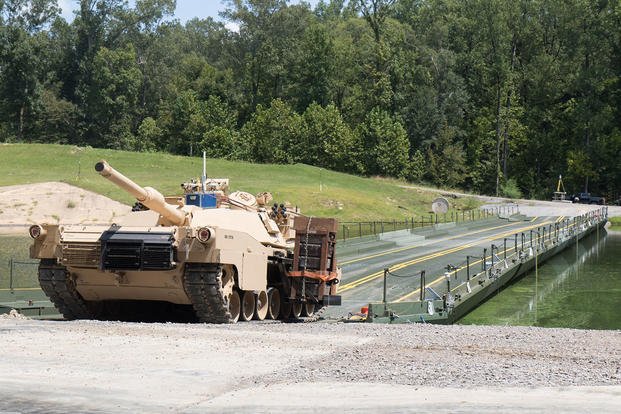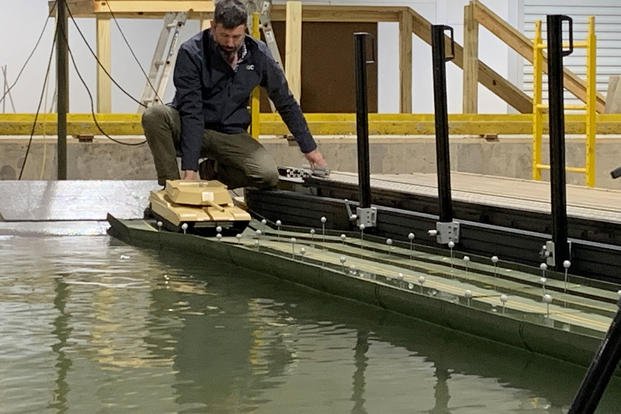Russia suffered an embarrassing public setback in Ukraine’s Donbas region in May when its soldiers attempted to cross the Siverskyi Donets River and ended up taking a bath instead – reportedly losing a significant number of troops and tanks in the process. The U.S. Army, which coolly called out the failure not long after, is a recognized leader in proficient “wet gap” crossings. And now Army engineers are working to make its elite bridging technology even more dependable and effective.
The U.S. Army Engineer Research and Development Center, in partnership with Program Executive Office Combat Support, is now pushing the outer limits of vehicle weight load capacity for the Improved Ribbon Bridge, according to an announcement from the Army Corps of Engineers. The floating bridge, which has been used by both the Army and Marine Corps since 2003, is designed to carry 105 wheeled, or 85 tracked vehicles, according to published specifications. In extreme situations, that load can be increased to 110 wheeled or 90 tracked, with caution.
Water conditions matter, too. Specifications state that the modular bridge can be used over river currents of up to 10 feet per second; it can be used as a single-piece temporary crossing mechanism, or divided up into pieces for rafting operations.
Using a series of full-scale and miniature models to simulate both vehicle load and water conditions, the testing team now wants to see how much more they might be able to get out of the system they have.
“We are able to look at the IRB and test it against different loading and hydrodynamic conditions to determine operational conditions in which the IRB can be deployed and subject it to increased weight and heavier vehicles,” Stephanie Robert, program manager and research civil engineer with the ERDC’s Geotechnical and Structures Laboratory, said in a statement.

Building bridges
In September 2021, the team, including personnel from the Mississippi Army National Guard and Alabama’s Anniston Army Depot, completed a first test phase, which involved full-scale water testing in a test basin of bridge components with military vehicles at different weights and travel speeds, according to the release.
They started with smaller wheeled and tracked vehicles to establish a baseline, then gradually introduced bigger, heavier systems to see how the bridge would take it. It’s not clear from the release which vehicles were introduced onto the bridge or how the IRB fared in the test; officials with the Army Corps of Engineers did not immediately respond to queries.
To complete the most comprehensive experiments, however, testers needed to go much smaller. Last October, the team began small-scale model testing, with a ribbon bridge inside an indoor water tank and tactical vehicles the size of Tonka trucks. Engineers explained that this way, they can validate what large-scale testing had shown and also introduce whatever water conditions and speeds they choose, from lazy rivers to whitewater rapids.
“We can introduce river velocities, so we can ramp the river velocity up or down depending on what we are trying to simulate,” said Dr. Duncan Bryant, a research hydraulic engineer with ERDC’s Coastal and Hydraulics Laboratory.
“As the water comes in, it impacts the IRB and changes the hydrodynamics. There is an operational space where it’s just too much flow for the bridge, and as you add more weight, that operational space changes. The way to do that safely is a scaled model. Here we don’t have to worry about sinking a tank or sinking a bridge, and we can try a lot of different scenarios out without any risk to anybody or any property,” Dr. Bryant added.

After the small-scale testing finishes at a to-be-determined date, computational modeling and analysis will begin; this will be the third and final phase of the effort.
The end goal is a new set of specifications that will include data about the types and extreme limits of the river crossings the IRB is approved for, how fast vehicles can travel over the bridge, and how many bays, or bridge pieces, are needed for various crossing conditions.
Made by General Dynamics, the IRB is designed to be transported in pieces by specialized vehicles and assembled with the aid of a hydraulic system. The Army says Soldiers can build a 100-meter, 15-piece bridge in just half an hour.
By contrast, the Russian Army’s pontoon bridge system met with what appears to be an abject failure in the Donbas. In the attempted Siverski Donets crossing, undertaken in an attempt to secure maneuver routes and assault several Ukrainian towns on the other side, some 400 Russian soldiers were reportedly killed or wounded, and dozens of tanks destroyed.
In response to Russia’s failed attempt, the U.S. Army Europe and Africa wrote the following on Twitter:
One of the riskiest maneuver operations
Stateside, too, U.S. Soldiers and Marines are honing their wet gap crossing skills to maintain their dominance. In June, units from both services conversed on Joint Base Lewis-McChord, Washington, for Exercise Courage Crossing, a three-day event in which they built a 360-foot IRB across a lake and drove a long convoy of heavy tactical vehicles from one side to the other.
Army officials have elsewhere described wet gap crossings as one of the riskiest ops a maneuver force can undertake. This is because bridge components are unarmored, and the troops who work to assemble the bridge have no shelter from enemy fire. Units must move fast to minimize risk.
“Wet gap crossing operations are important to enabling maneuver forces to close with and destroy enemy forces by giving them one of the most valuable fundamentals of war – speed,” Captain Shederick F. Mullgrav, the commander of the Army’s 45th CBRN Company, said in a news release about the event.
“Tempo is the key to seize the initiative, prevent enemy reconnaissance and exploit success. Executing a safe and efficient wet gap crossing will allow friendly forces to set conditions necessary for success,” he added.
Hope Hodge Seck is an award-winning investigative and enterprise reporter who has been covering military issues since 2009. She is the former managing editor for Military.com.
Read the original article on Sandboxx













